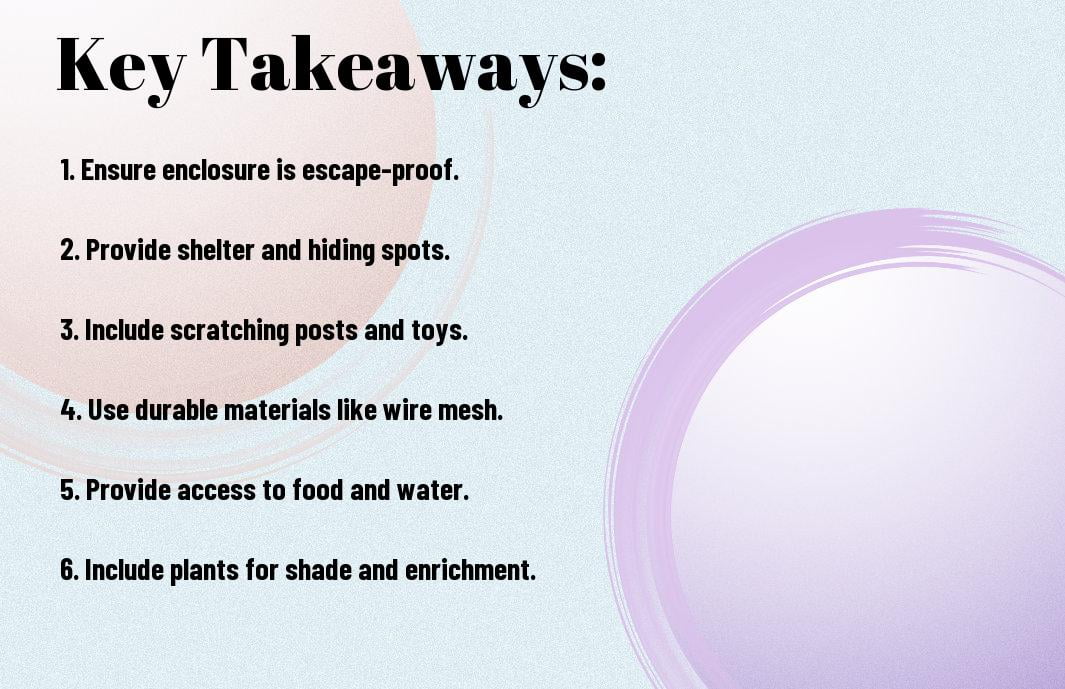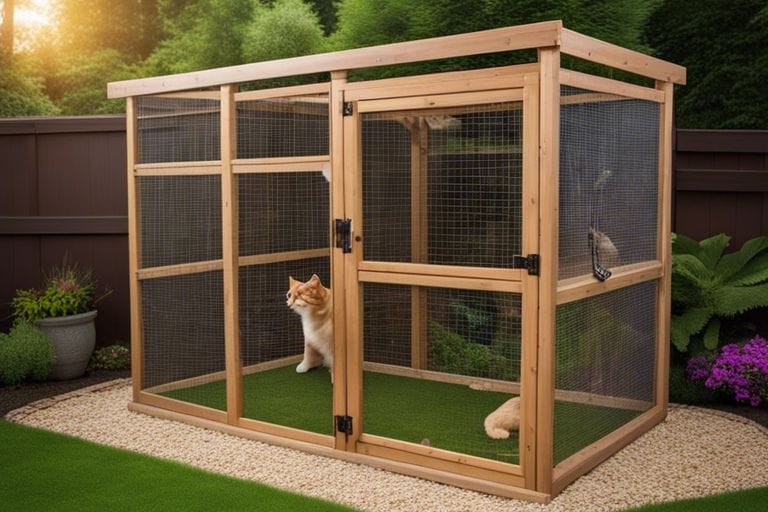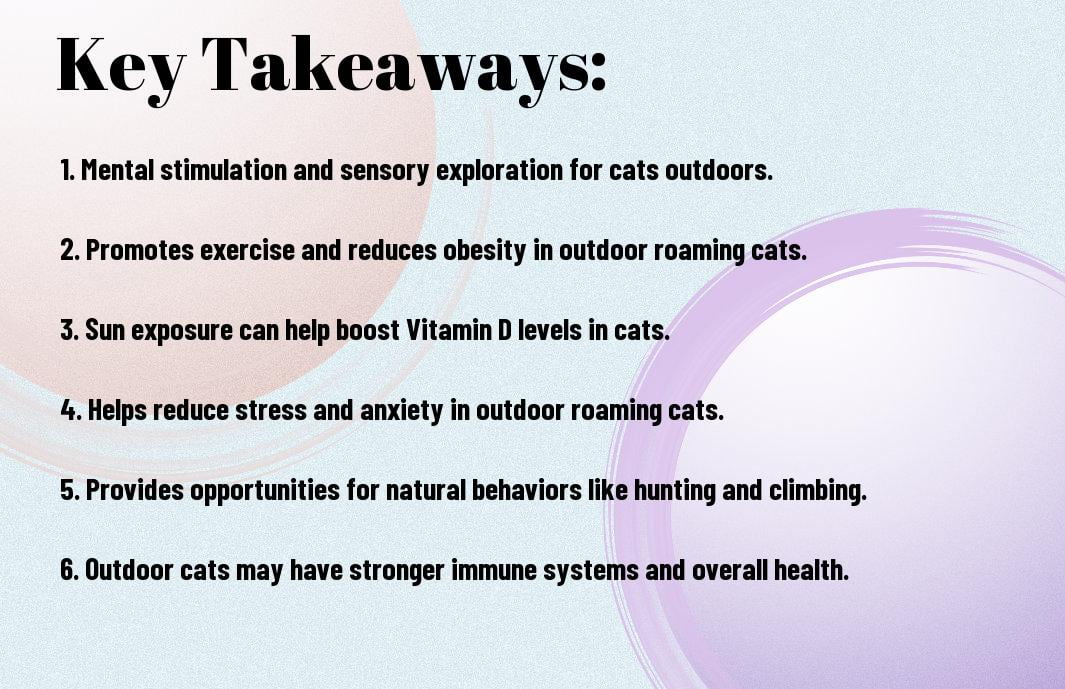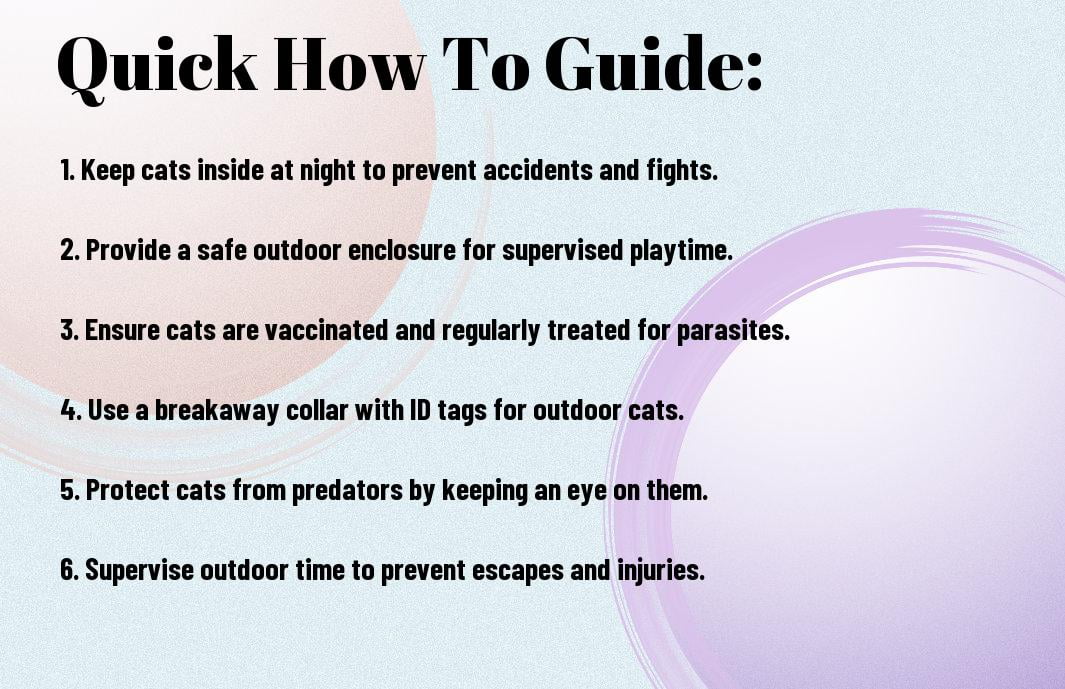Catios, or outdoor cat enclosures, are a fantastic way to provide your feline friend with a safe and enriching outdoor experience. By building a DIY outdoor cat enclosure, you can give your cat the opportunity to enjoy the sights, sounds, and smells of the outdoors while keeping them protected from potential dangers such as predators or traffic. In this blog post, we will walk you through the steps of creating your own outdoor cat enclosure, providing valuable tips and insights along the way to ensure a successful and safe outdoor space for your beloved cat.

Planning Your DIY Outdoor Cat Enclosure
Considering the Location
Your outdoor cat enclosure’s location is crucial to your cat’s safety, enjoyment, and your convenience. Ensure the spot you choose is easily accessible for cleaning and maintenance. Also, consider placing the enclosure in an area that receives a good amount of sunlight for warmth and light.
Determining the Size and Shape
Determining the size and shape of your outdoor cat enclosure is vital to ensure your cat has enough space to roam and explore. Consider the number of cats that will be using the enclosure and their activity level. A general rule of thumb is to provide at least 4 square feet of space per cat.
The shape of the enclosure can vary based on available space and your cat’s preferences. Consider incorporating vertical space for climbing and perching, as well as horizontal space for running and playing.
Assessing Materials and Durability
Considering the materials used for your outdoor cat enclosure is vital for its longevity and your cat’s safety. Opt for weather-resistant materials like pressure-treated wood, PVC piping, or galvanized steel mesh. These materials are durable and can withstand outdoor elements.
It’s important to assess the durability of the materials you choose to ensure they can withstand your cat’s scratching, jumping, and climbing activities. Avoid materials that are easily broken or damaged, as this can pose a risk to your cat’s safety.
Accommodating Your Cat’s Needs
The design of your outdoor cat enclosure should take into account your cat’s needs and preferences. Include areas for your cat to sunbathe, hide, play, and explore. Consider incorporating scratching posts, perches, shelves, and toys to keep your cat entertained and engaged.
Understanding
The ultimate goal of planning your DIY outdoor cat enclosure is to create a safe and stimulating environment for your feline companion. By carefully considering the location, size, shape, materials, and your cat’s needs, you can create a space that your cat will love and you can enjoy watching them thrive in.

Designing the Enclosure
Choosing a Design That Fits Your Space
With outdoor cat enclosures, one size does not fit all. It’s crucial to select a design that will work well in the space you have available. Start by measuring the area where you plan to install the enclosure. Consider factors such as the shape of the space, any existing structures, and the terrain. This will help you determine whether a freestanding enclosure, a window box style, or a tunnel system would be the best option for your outdoor space.
Safety Features to Include
Designing a safe outdoor cat enclosure is a top priority. Ensure the enclosure is made from durable materials that will withstand the elements and keep your feline friends secure. Include features like secure latches on doors, mesh walls to prevent escapes, and a sturdy roof to protect your cats from predators. Consider adding cat-friendly plants and shady spots to provide a comfortable environment for your outdoor kitties. Safety should always be at the forefront of your design process.
When designing the enclosure, think like a cat. Cats are clever escape artists, so be sure to eliminate any potential gaps or weak points where your cats could get out or predators could get in. Regularly inspect the enclosure for wear and tear, and make any necessary repairs promptly to maintain a safe environment for your pets.
Accessibility for Humans and Cats
Choosing a design that allows for easy access for both humans and cats is important. Consider incorporating walk-in doors for cleaning and maintenance, as well as ramps or steps to allow your cats to move freely between levels. Including windows or mesh panels that can be opened for ventilation will ensure a comfortable environment for your feline companions.
Safety is key when it comes to accessibility. Be mindful of potential hazards such as sharp edges, toxic materials, or gaps that could pose a risk to your cats. Creating a safe and accessible space will promote healthy living for your outdoor cats and ease of maintenance for you.
Including Exercise and Play Areas
Fits Cats need plenty of stimulation and exercise, even in an outdoor enclosure. Include features such as climbing trees, scratching posts, and perches to keep your cats entertained and engaged. Cat tunnels, platforms, and hiding spots can also provide mental stimulation and opportunities for play. Incorporating a variety of textures and heights will mimic a natural outdoor environment and keep your cats physically active.
With a well-designed exercise and play area, your outdoor enclosure can become a paradise for your feline friends. Consider adding toys and interactive elements to keep your cats happy and healthy while they enjoy the great outdoors in a safe and secure space.
Gathering Materials and Tools
List of Necessary Materials
Many different materials are required to build a sturdy and safe outdoor cat enclosure. To begin, you will need wire mesh or fencing material to create the walls and ceiling of the enclosure. Additionally, wooden posts or PVC pipes will be necessary to provide support and structure for the frame. Other imperative materials include screws, hinges, a latch for the door, and weatherproof paint or sealant to protect the enclosure from the elements.
Tools Required for Construction
To construct an outdoor cat enclosure, you will need an assortment of tools to complete the project efficiently. Some imperative tools include a power drill with different bits for drilling holes and driving screws, a saw for cutting wood or PVC pipes to size, and a tape measure to ensure accurate measurements. Other useful tools include a hammer, screwdriver, wire cutters, and a level to ensure the enclosure is straight and properly aligned.
An outdoor cat enclosure project also requires some specialized tools. A staple gun will be needed to secure the wire mesh or fencing material to the frame, while a post hole digger may be necessary to create holes for the wooden posts if you choose to use them. These tools, combined with the basic toolkit, will set you up for success in building a durable and secure outdoor space for your feline friends.
Cost Estimation and Budgeting
With careful planning and budgeting, building your own outdoor cat enclosure can be a cost-effective and rewarding project. The overall cost of the project will depend on the size of the enclosure, the materials selected, and any additional features you choose to include. It is advisable to create a detailed list of materials and their estimated costs to help you stay within your budget.
The cost of building an outdoor cat enclosure can vary significantly depending on your location and the availability of materials. By comparing prices at different stores and looking for sales or discounts, you may be able to save money on the overall cost of the project. Remember to factor in any additional expenses, such as tools or paint, when budgeting for your DIY outdoor cat enclosure.
Cost should not be the only consideration when building a cat enclosure; quality materials and construction are imperative for ensuring the safety and durability of the structure. By carefully planning and budgeting for your project, you can create a comfortable and secure outdoor space for your cats to enjoy for years to come.
Construction Steps
Preparing the Foundation
With any construction project, a solid foundation is crucial for the structure’s stability and longevity. Before you start building your DIY outdoor cat enclosure, take the time to prepare the foundation. Clear the area where the enclosure will be placed, ensuring it is level and free from any debris that could cause issues later on. You may need to use a shovel or a level to ensure the ground is even.
Building the Frame
On to the exciting part – building the frame of your outdoor cat enclosure! This step involves constructing the basic structure that will hold the fencing and roofs in place. You can use materials like PVC pipes or wooden beams to create a sturdy frame that can withstand outdoor elements. Consider the size and shape of your enclosure when designing the frame to ensure it will provide enough space for your furry friends to roam and play.
Plus, make sure to securely attach all joints and corners to prevent the frame from becoming wobbly or unstable. Using screws or brackets can help reinforce the frame and provide added strength to support the weight of the enclosure’s components.
Installing Fencing and Roofs
On to the next step – installing the fencing and roofs of your outdoor cat enclosure. This part is crucial for keeping your feline friends safe and secure while they enjoy the great outdoors. Choose a durable and weather-resistant material for the fencing, such as chicken wire or mesh, to prevent any escape attempts by your cats.
Securing the Enclosure to Prevent Escapes
To ensure that your outdoor cat enclosure is escape-proof, you’ll need to take extra precautions to secure all access points. This includes adding secure latches to any doors or gates and double-checking that there are no gaps or weaknesses in the fencing that could allow your cats to slip through. Be mindful of, cats are crafty creatures, so it’s important to be thorough in checking for any potential escape routes.
Roofs
Preparing a roof for your outdoor cat enclosure is crucial to provide protection from the elements and keep your cats safe and comfortable. You can use materials like corrugated plastic or outdoor fabric to create a roof that is both durable and weather-resistant. Make sure the roof is securely attached to the frame to prevent it from being blown off during windy weather.
Landscaping and Environmental Enrichment
Adding Natural Elements
Once again, creating an outdoor cat enclosure that mimics a natural environment is crucial for your feline friend’s well-being. Including natural elements such as plants, bushes, and grass patches can provide a sense of the outdoors while also offering opportunities for them to explore, sniff, and interact with their surroundings.
Creating Hideaways and Shelters
For creating hideaways and shelters in your DIY outdoor cat enclosure, consider incorporating cozy nooks, small shelters, or even elevated platforms where your cat can retreat and feel safe. These hideaways can be made from a variety of materials, including wood, PVC pipes, or even repurposed items like old crates or barrels.
Adding multiple shelters throughout the enclosure can also help in establishing territorial boundaries for multi-cat households and give each cat a space to call their own.
Fun Additions: Perches and Climbing Structures
Additions such as perches and climbing structures are crucial for providing vertical space for your cats to explore and play. Cats naturally love to climb and perch up high to survey their surroundings, so incorporating shelves, cat trees, or climbing posts can keep them mentally and physically stimulated.
With carefully placed and securely installed perches and climbing structures, your outdoor cat enclosure will offer endless opportunities for your feline companions to exercise, entertain themselves, and indulge their natural instincts.

Maintenance and Upkeep
Routine Cleaning Guidelines
Guidelines for routine cleaning of your DIY outdoor cat enclosure are crucial to ensure a healthy and safe environment for your feline companions. Regularly remove any waste, debris, or uneaten food from the enclosure to prevent unpleasant odors and potential health hazards. Clean the enclosure surfaces with a pet-safe disinfectant to maintain a hygienic living space for your cats.
Inspecting and Repairing the Enclosure
Guidelines for inspecting and repairing the DIY outdoor cat enclosure involve regularly checking the integrity of the structure. Look for any signs of wear and tear such as loose screws, broken meshes, or damaged panels. Promptly repair any issues to prevent potential escape or injury to your cats.
This proactive approach to maintenance will ensure that your outdoor cat enclosure remains a secure and comfortable space for your cats to enjoy.
Seasonal Considerations and Adjustments
Any seasonal changes may require adjustments to the DIY outdoor cat enclosure to ensure the comfort and safety of your cats. In hot weather, provide ample shade and water sources to prevent heat stress. Similarly, in cold weather, add blankets or extra insulation to keep your cats warm and cozy.
Plus, consider adding special features like a heated bed or a cooling pad to make the enclosure more comfortable for your cats during extreme weather conditions.
Final Words
Ultimately, building a DIY outdoor cat enclosure is a great way to provide your feline friend with a safe and enriching environment to explore the outdoors. By following the steps outlined in this guide, you can create a space that allows your cat to experience the fresh air and sunlight while protecting them from potential dangers such as traffic or predators.
Remember to consider your cat’s needs and preferences when designing and building the enclosure, and regularly inspect and maintain the structure to ensure its safety and durability. With a little bit of time and effort, you can create a space that both you and your cat will enjoy for years to come.
FAQ
Q: What is a DIY outdoor cat enclosure?
A: A DIY outdoor cat enclosure is a structure built by cat owners to provide a safe and secure outdoor space for their cats to enjoy fresh air and sunshine while preventing them from roaming freely.
Q: Why should I build an outdoor cat enclosure?
A: Building an outdoor cat enclosure allows your cats to experience the outdoors safely, reducing the risk of accidents, diseases, and fights with other animals. It also provides mental and physical stimulation, promoting their overall well-being.
Q: What materials are needed to build a DIY outdoor cat enclosure?
A: To build a DIY outdoor cat enclosure, you will need materials such as PVC pipes, wire mesh, hinges, latches, outdoor fabric or netting, zip ties, and tools like a saw, drill, and screwdriver.
Q: How big should an outdoor cat enclosure be?
A: The size of your outdoor cat enclosure depends on the number of cats you have and their activity levels. It is recommended to have at least 4 square feet of space per cat to allow for room to move, play, and exercise.
Q: Are there any safety precautions to consider when building a DIY outdoor cat enclosure?
A: When building a DIY outdoor cat enclosure, make sure to use cat-safe materials, secure all edges and corners to prevent escape or injury, provide shade and shelter, and regularly inspect the enclosure for any wear or damage that may compromise its safety.
















